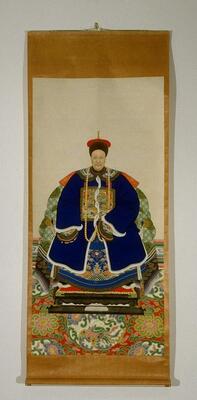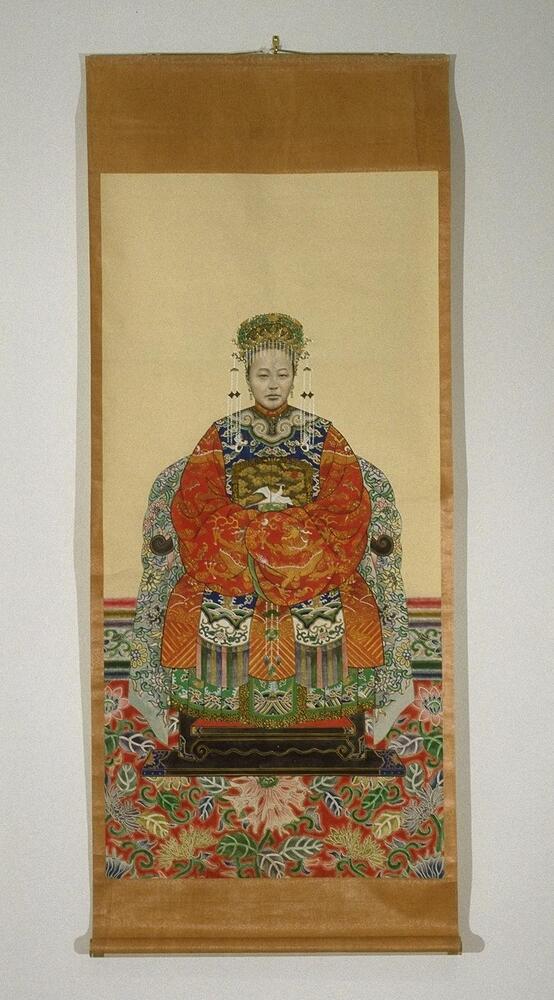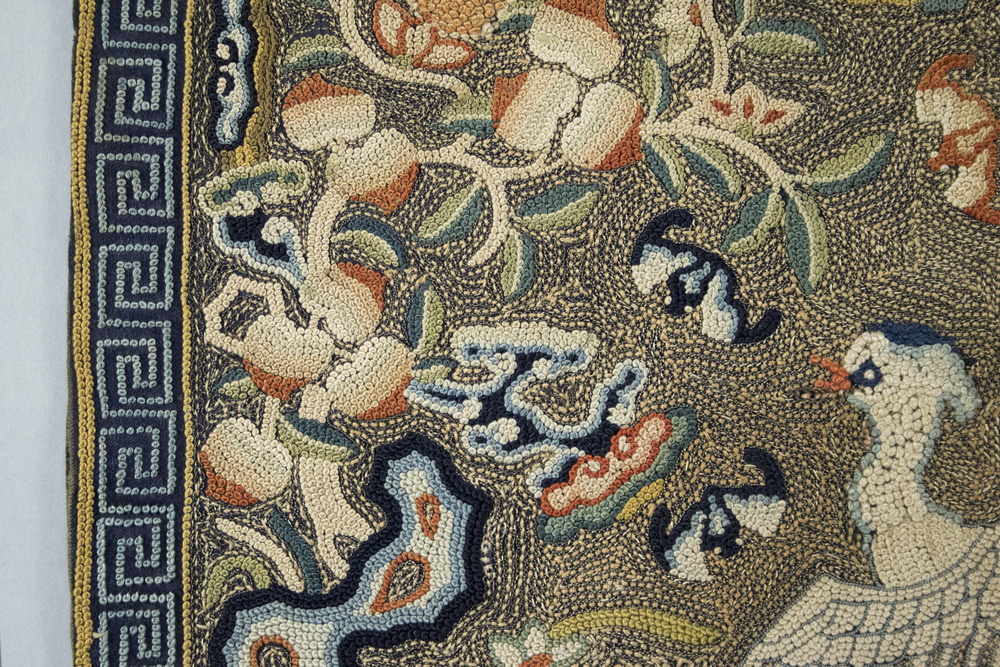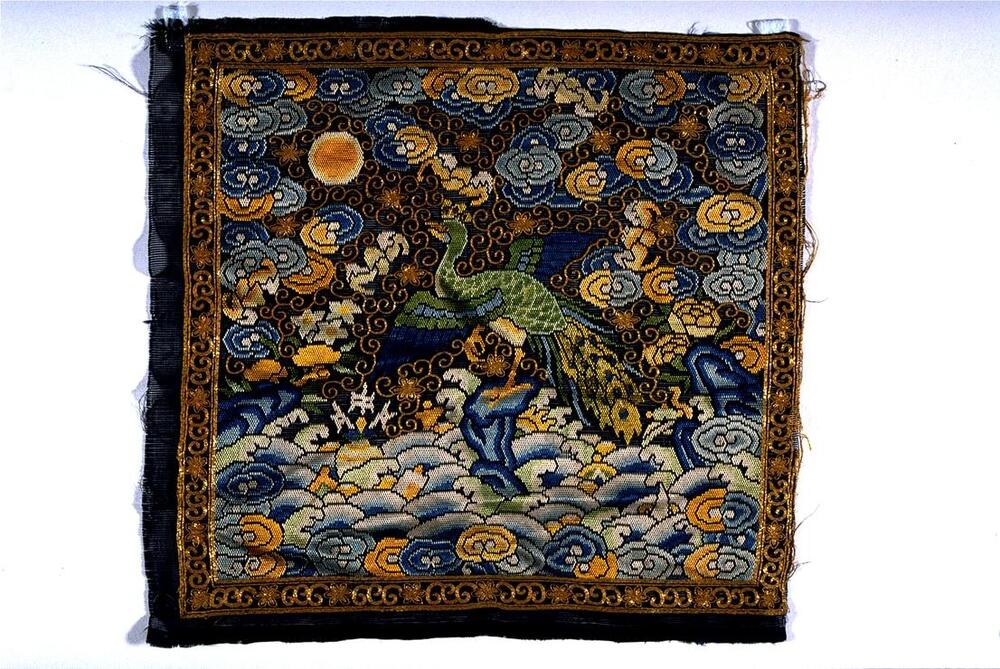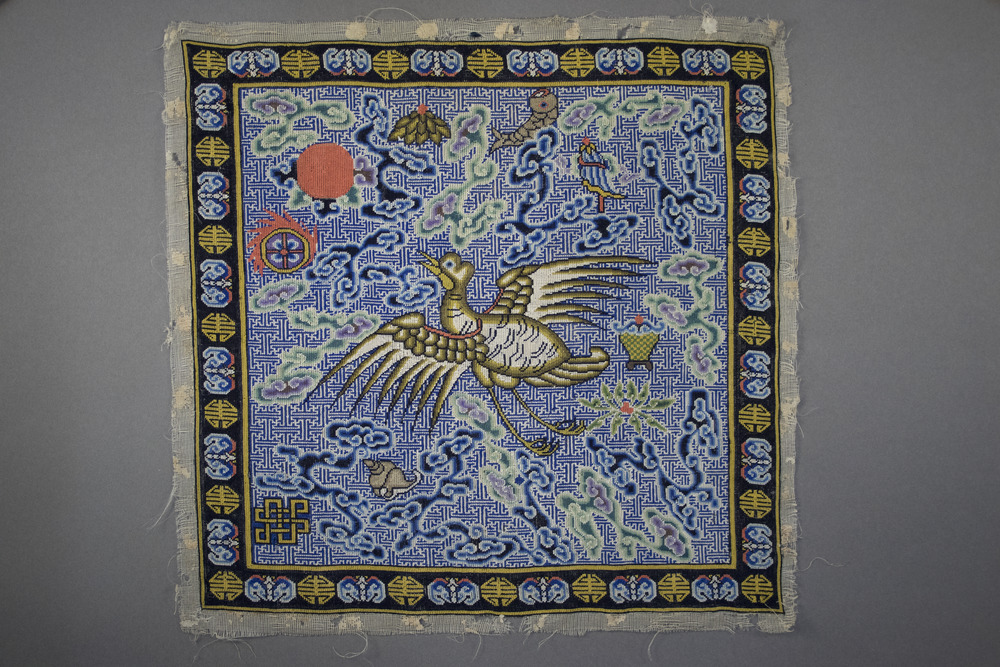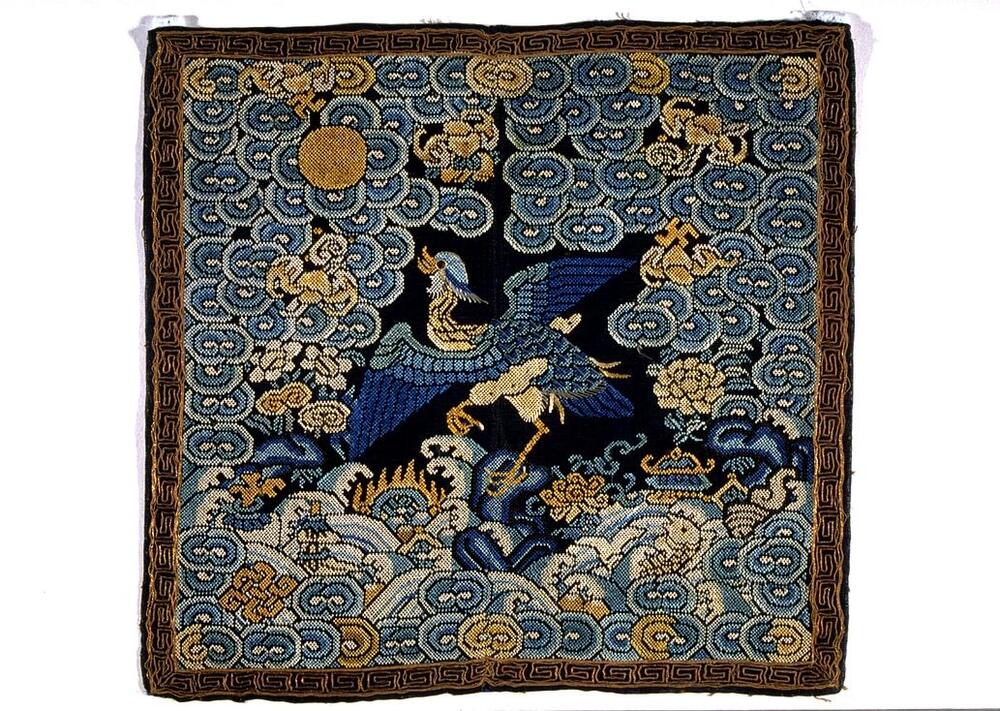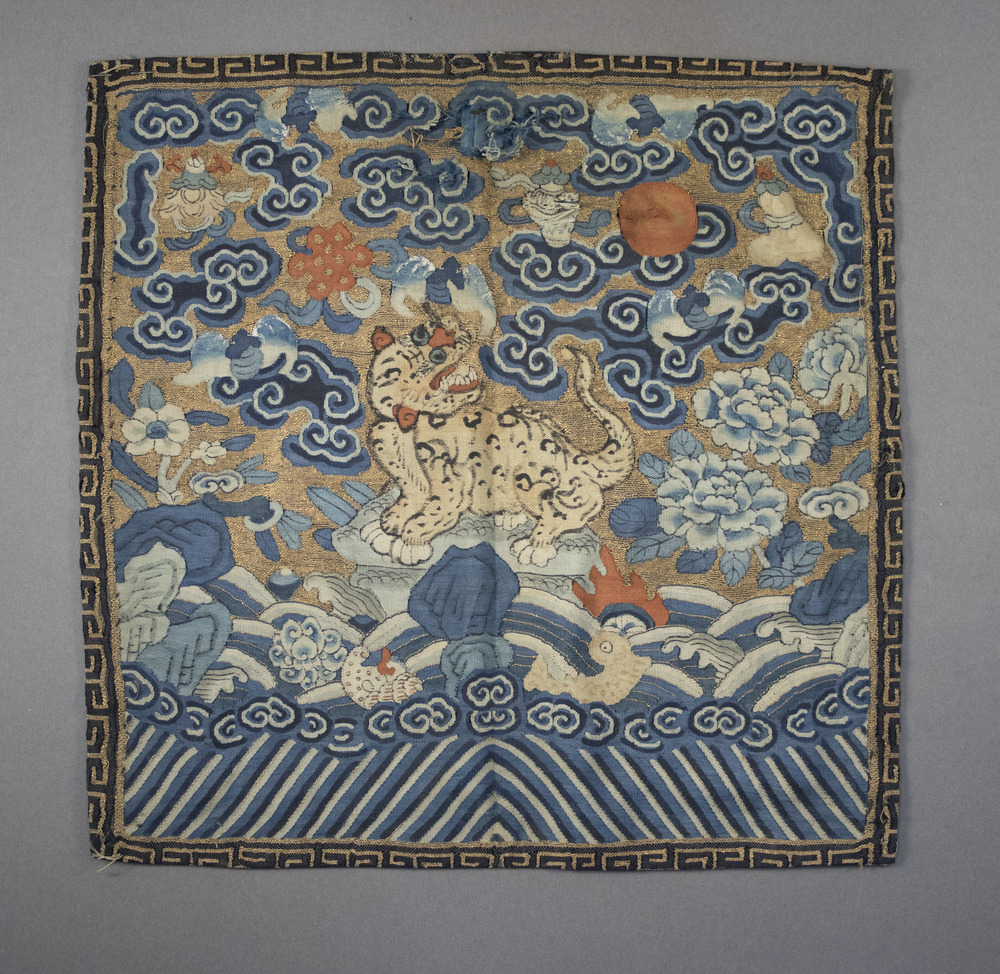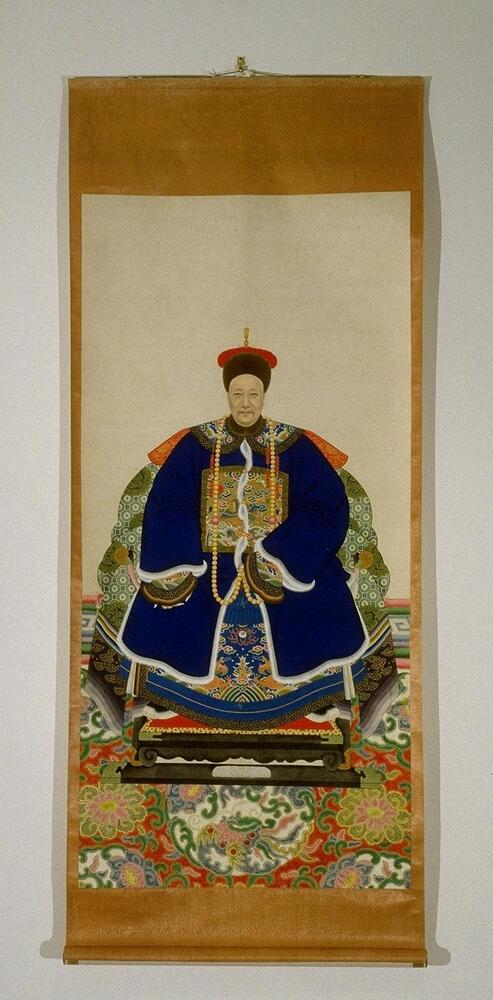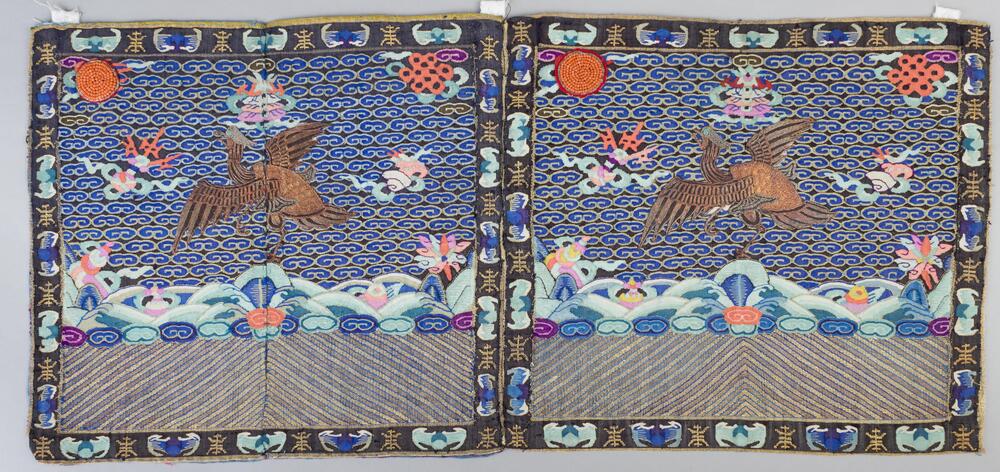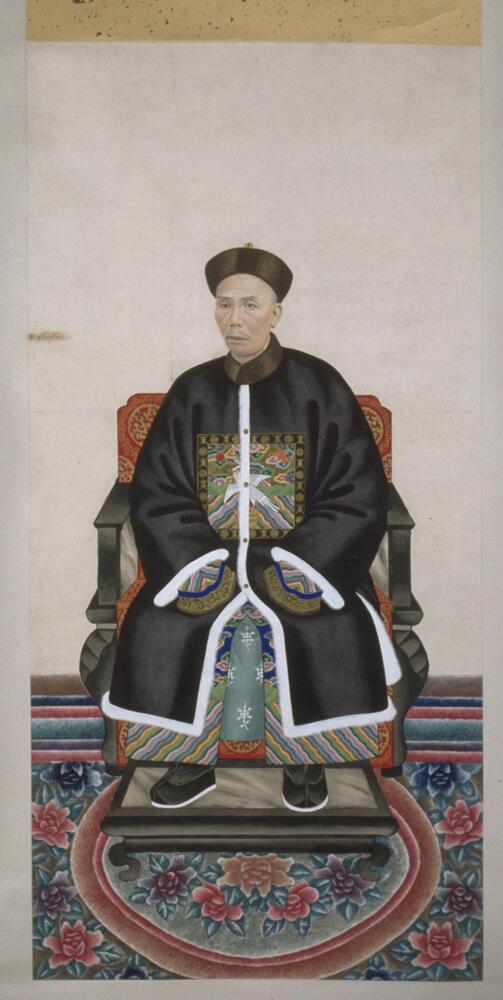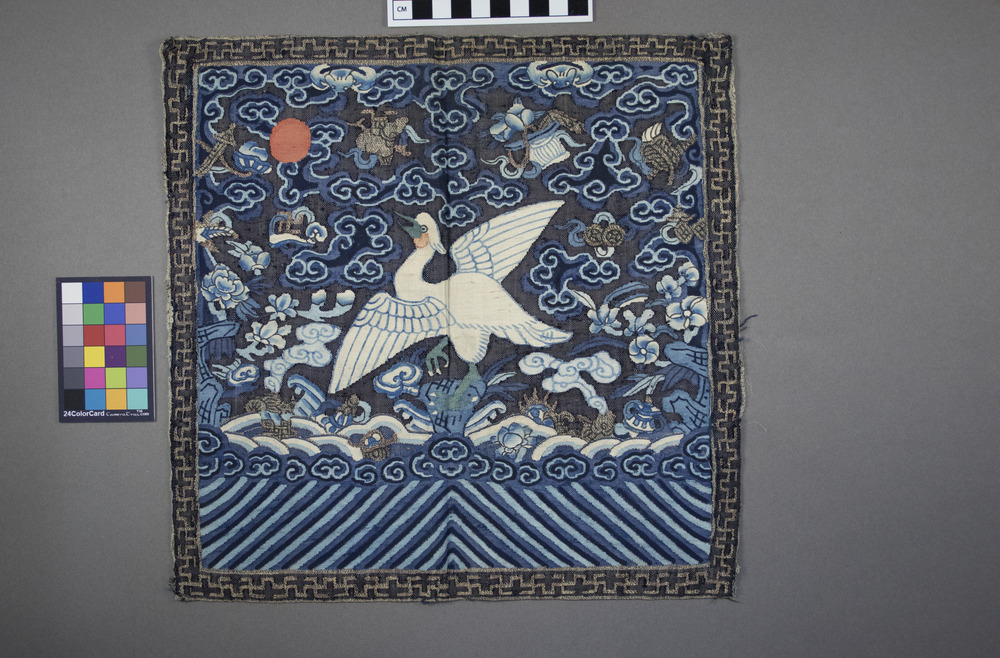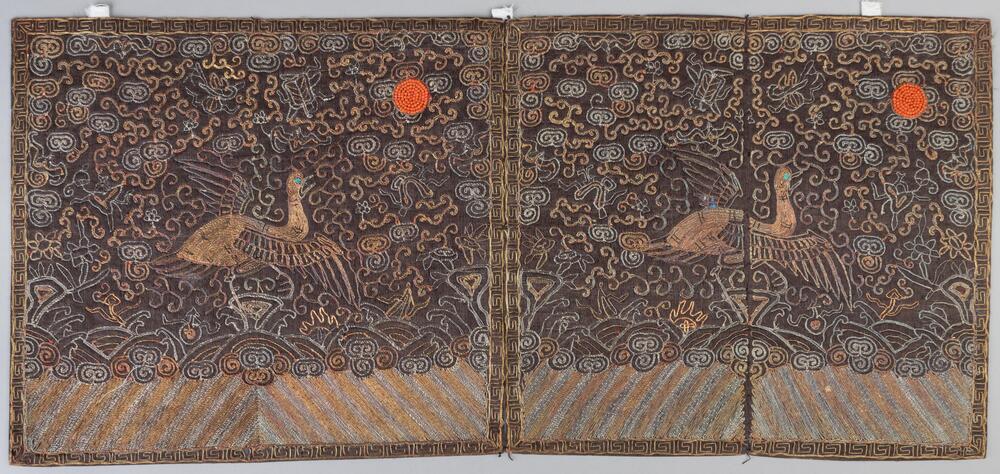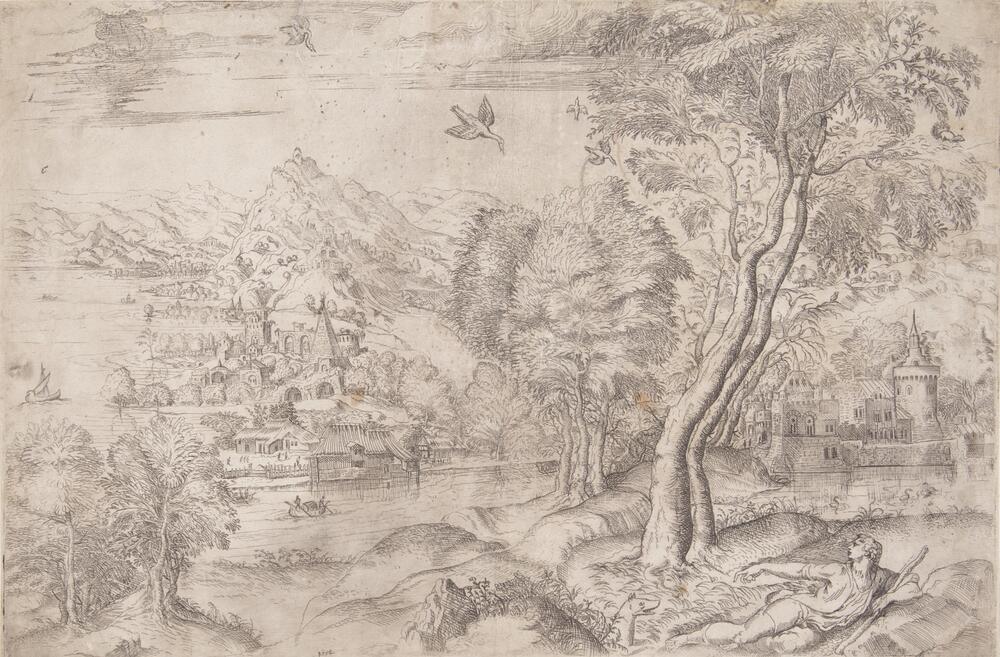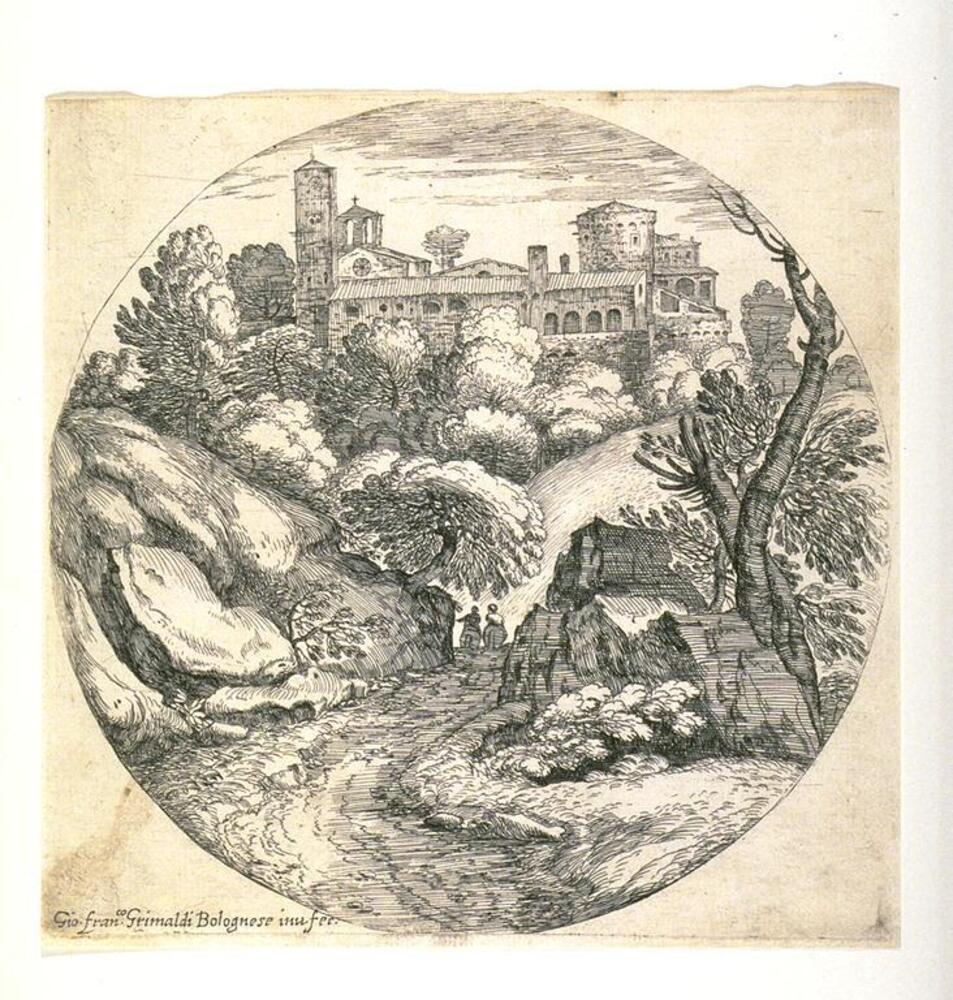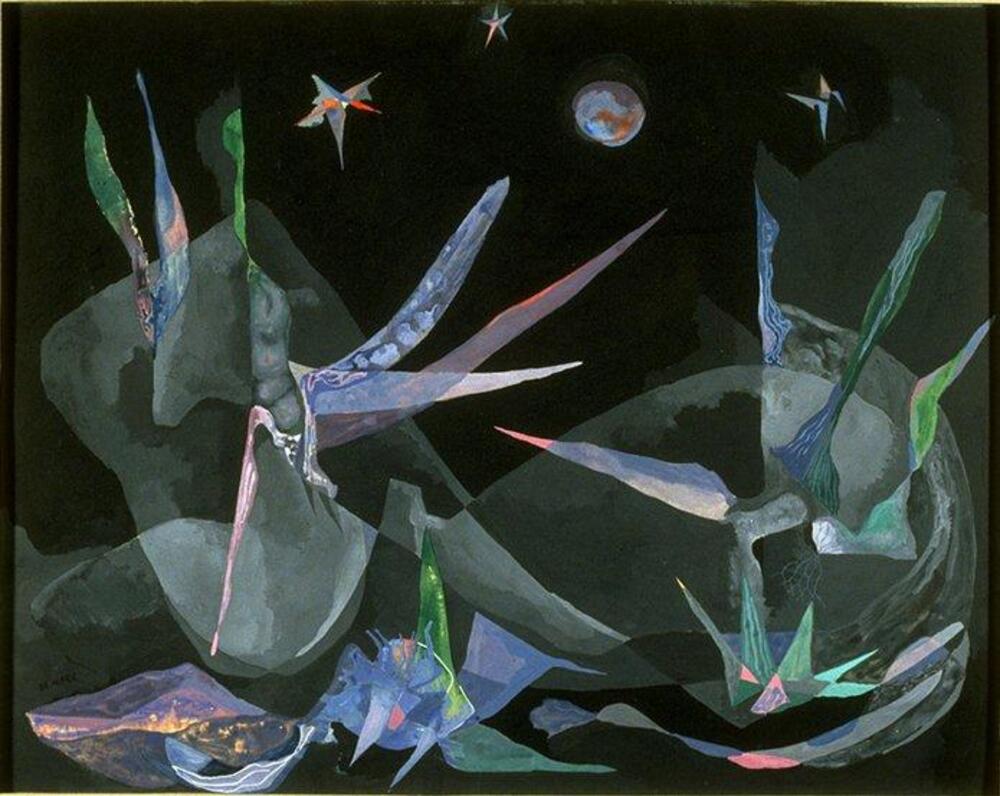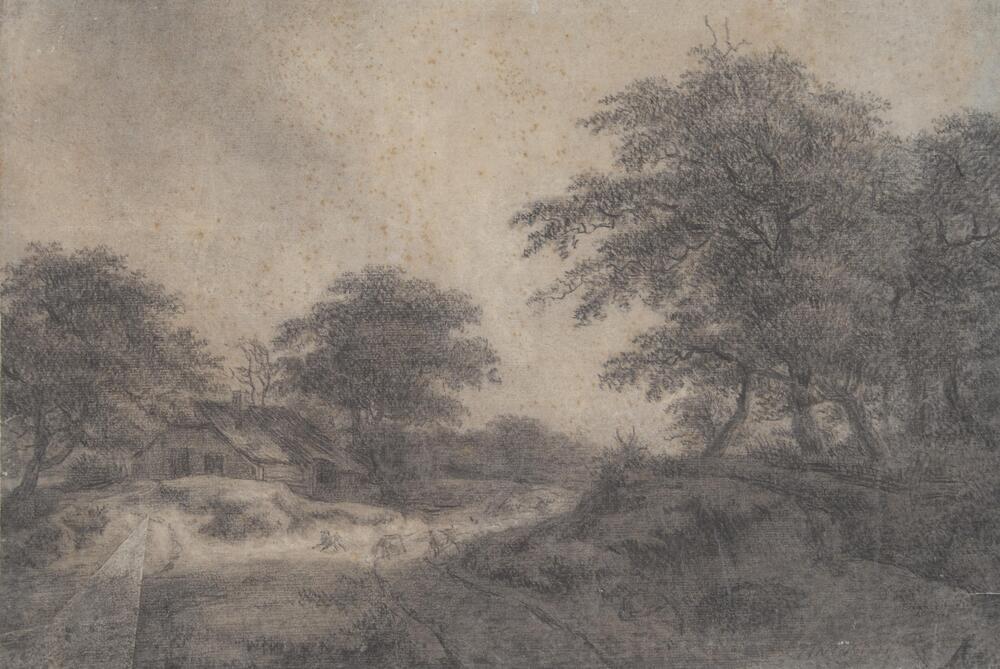Qing-dynasty rank badges at the University of Michigan
Rank badges (bŭzǐ) of China, often called mandarin squares by collectors, were worn as signifiers of civil, military, or imperial court rank during the Qing dynasty (1644–1912). The custom of wearing rank badges at court concretely dates to the Ming dynasty (1368–1644). The following Qing dynasty was founded by a clan from northern Manchuria that facilitated the fall of the Ming dynasty. To stabilize their reign, the Manchus had to balance their own traditions with those of the Han Chinese. While incorporating some Manchu characteristics among the Han Chinese, including new modes of dress at court, they retained some aspects of Ming-dynasty bureaucracy such as the use of rank badges. Rank badges were altered to fit the Manchu cut of clothing, creating badges that were smaller than the preceding Ming badges. The badges were worn on both the front and the back of robes. The front badge was split down the middle for the robe opening—as seen in the hanging scroll to the right.
There were nine ranks each for civil and military positions and, accordingly, nine figures that could be found on badges for each. Civil badges display a range of nine bird types in contrast to the military badges’ nine animal figures. The presence of a sun on non-Imperial badges was introduced during the Qing dynasty. While some scholars date this introduction to the mid-eighteenth century, others situate it during the Kangxi Emperor's reign (r. 1662-1722). On civil badges, the sun was on the upper left corner because civil officials would be seated to the Emperor's left. Therefore the sun would be on the side of the badge closest to the Emperor and the bird would be turned toward both the sun and the Emperor. Military badges have the sun in the upper right because military officials were seated to the Emperor's right. For social events, women could wear a complementary badge signifying their husband’s rank or, if not yet married, their father’s. Seen in the hanging scroll to the left, wives' badges were mirrored versions of their husband's so that when they were seated at social events together with the wife seated to the right of their husband (in domestic situations, the left-hand seat was the seat of honor and reserved for the husband), their badges would harmoniously face each other. This worked well for civil officials and their wives, but a military husband's badge animal would face away from his wife, seated on his right, and present a disharmonious image. Therefore military badges show more variation and innovation in placing the animals. Often the animal's body faces the spouse while the head is turned to look over the shoulder at the sun, ensuring both respectful comportment toward the Emperor and presenting marital harmony. This is seen in a few examples shown in the military section below. Examples of animals' bodies and faces facing a sun were made for strictly social occasions so the civil official would not have worn it around the Emperor and thus would not have made any insult toward the ruler. Closer to the end of the Qing dynasty and as the power of the Emperor waned, social and political restrictions on the badges became looser, though no examples of such works are in the University of Michigan's collections.
There were various production processes to create badges. Although most works were embroidered, another technique for making these badges was also weaving (brocade badges).
Many of the embroidery stitches are used in combination with one another on single works. One of the types of embroidery stitch used was the seed stitch. This stitch is also known as the Peking knot, French knot, ring embroidery, or (erroneously) the forbidden stitch. The stitch, neat knots of thread on the surface of works, was made by wrapping thread around the needle and then stitching it down.
A stitch called the Pekinese stitch can sometimes be mistaken for the seed stitch, but it is quite different. First a long, loose back stitch is executed, then the thread is laced back through the stitch, creating a series of loops. This stitch has often been used for linear elements in Chinese embroideries.
The couching stitch attaches sections of thread to bases, using small regular stitches. This is seen in the work below.
Long and short stitches were generally used for flowers, tree trunks, and rocks. These layers of stitches present a flat and thin face with visible stitches and allow some flexibility in form and color gradations.
While there are many more details about rank badges and their history, this resource focuses on providing basic information and examples from the collections at the University of Michigan (the Museum of Art and the Museum of Anthropological Archaeology).
Civil Rank Motifs
Rank 1: crane
The University of Michigan does not have any badges of this rank, but to see an example, click here.
First rank civil official was the highest rank and the crane symbolized longevity and wisdom. Generally, the crane is shown as a white bird with a red-capped rounded head. There is some variation with the body either smooth or with a scaled design of feathers. As with many other bird designs on the rank badges, the tail can be key in identifying the type of bird. The crane's tail feathers are generally short, stubby, spade shaped, and black with points separated from one another. Many crane badges show the bird with red or blue-green legs and long beaks, which may be on of the most reliable forms of identification.
Rank 2: golden pheasant
A golden pheasant, symbolizing duties and obligations, was the second rank for civil officials. These birds were generally depicted in two ways: either in variegated color or a more monochrome version of golden threads. Either way, identifying the bird is easiest by looking to its tail feathers. The golden pheasant's tail has two sword-shaped feathers that have black bars along them. Additionally, this pheasant is usually shown with a crested head.
Rank 3: peacock
The peacock denotes elegancy, dignity, and beauty. Easily identified by the well-known "eye" design on the tail feathers, this bird is colorfully embroidered, often in shades of green. The heads of this depicted bird were generally smooth, though at times with a small feather or two with the same "eye" design that the peacock tails have.
Rank 4: wild goose
The wild goose is a symbol of loyalty and marital bliss, like the mandarin duck. This bird is usually mustard yellow, tan or gold with a smooth head. The two particular characteristics of this bird are its wedge-shaped tail and the representation of body feathers by small pairs of black marks often in comma-like shapes.
Rank 5: silver pheasant
While sometimes shown in blue, it is generally white and often has a crested head. Paired with the color, the distinctive serrated- or scalloped-edge tail feathers identify this bird. In the early Qing period, the pheasant had three of these tail feathers, but the number later increased to five.
Rank 6: egret
The head can be either smooth or crested, but if smooth it usually has a small feather or two attached. The legs can be a variety of colors, but green and yellow seem to be most common. Its wedge-shaped tail distinguishes it from other white birds such as the crane and silver pheasant. This example from UMMA's collection diverges from the standard depiction due to the lack of a wedge-shaped tail (seen in the example from UMMAA to the right). These variations could happen due to mistakes, but at times it was a technique to imply a different rank. At first glance, the bird with the five separated tail feathers could be a silver pheasant. An accusation of misrepresentation could be argued by pointing out the lack of the distinctive scalloped edge of the silver pheasant's tail feathers. Still, the ambiguous tail feathers of UMMA's egret rank badge hints at ambitions to be seen as a higher-level civil official.
Rank 7: mandarin duck
The most colorful bird of all the rank badges, it generally had a crested head and a wedge-shaped tail. Its neck feathers denote this bird's identity, if the range of colors had not yet done so. The feathers on the mandarin duck's neck are typically in two tiers, each feather coming to a soft point and often curling up at the ends.
Rank 8: quail
The University of Michigan does not have any badges of this rank, but to see an example, click here.
The quail is a symbol of courage. Usually brown, it generally had a body with scale-like feathers with the feather's midrib explicitly shown. The tail was basically non-existent, with the body's feathers ending in a jagged edge.
Rank 9: paradise flycatcher
A white bird, its head can be either rounded, usually with a feather or two that matches its tail feathers, or crested. The distinctive tail has two long feathers narrower at the base with a single dot or eye near the end.
Military Rank Motifs
Military rank badges are rarer than civil badges. This is likely because the military, exclusively Manchu to ensure the stability of the Manchu/Qing government over the Han Chinese, was not viewed in a positive light during the Qing dynasty. When it was overthrown by the republican revolution in 1911, the military were particularly singled out for retribution. To escape such retribution (often violent), military men would destroy their official clothing to avoid detection. Unlike the military officials, the largely Han Chinese civil officials/scholars were incorporated into the new republican government. Because there was no animosity towards the civil officials, there was no need to destroy their badges and therefore many more civil badges are extant today.
Rank 1: qí lín
From 1662 to the end of the Qing dynasty, the first-rank military official badge illustrated a qí lín, a powerful mythical beast that represents longevity, grandeur, felicity, and wise administration. Prior to that point, both the first-rank and second-rank badges were a lion. This composite creature had a dragon's head with two horns, a stag's body, a fish's scales, and a Chinese bear's tail (with curls only at the base unlike a lion's which has curls at both the base and tip). There are also flames marking its status as a mythical beast, coming from its back and around the legs. Unlike all of the other animals and birds, the qí lín looks out at the viewer rather than the sun.
Rank 2: Lion
The University of Michigan does not have any badges of this rank, but to see an example, click here.
The second-rank military badge animal was a lion. Most often white, lions could also be depicted in blue. Lions are distinguishable from bears by the curls at the base and ends of mane (when long enough) and tail. Later Qing lion badges show the hair continue from the mane along the back to the tail, tips also curled. The flames that generally mark a mythical creature are part of the lion badge designs, which aligns with the fact that these lions are more like the mythical temple lions rather than naturalistic animals.
Rank 3: leopard
During the Ming dynasty, the leopard and tiger shared the third and fourth ranks and in the early years of the Qing dynasty the tiger was the third rank. From 1662 to the end of the Qing dynasty, the leopard solely represented the third military rank. These leopards were shown with either life-like spots or, later in the Qing dynasty, circles. At times, a badge leopard may have a circular star radiating lines on its forehead. It may, like the tiger badge, sometimes have the Chinese character for "king" (王) on its forehead. While flames may sometimes be seen somewhere on the square, they were usually not part of the body since a leopard is not a mythical creature. This particular badge, from UMMAA's collection, illustrates the visual ambiguities sometimes taken with badges and their animal rankings. Although it has the leopard spots, some areas have the lines of a tiger and some of the spots look almost comma-like, which was a feature of a tiger's stripe marks around the end of the Qing dynasty.
Rank 4: tiger
The University of Michigan does not have any badges of this rank, but to see an example, click here.
Compared to many other badge, the tigers in fourth-rank badges were depicted in a more naturalistic fashion. Earlier examples have more definition in the markings and, by the end of the Qing dynasty, the striped marks could look more like commas at times. The tiger was a symbol of bravery and courage, often used as a sign of military prowess and a protector of objects and people. Due to its status as kingly among beasts, it can often be found with the Chinese character for "king" (王) on its forehead. The flames that signify a mythical creature generally do not touch the body of a tiger in a rank badge, though they are still often included in the composition.
Rank 5: bear
The bear symbolizes strength and courage, and is an auspicious animal. Though indigenous to China, it is still normally shown with mythical flames extending from its body. Due to visual similarities with the lion badge, the bear rank can can often be misidentified as a lion (or second) rank. The bear's body can be either white or blue, like the lion, but in contrast the bear does not have curls at the ends of its mane or tail. There are only curls at the base. In the early Qing dynasty, the bear often had a longer muzzle and its claws were more pronounced.
Rank 6: panther
In China, the panther is seen as cruel and savage. It was the symbol of both the sixth and seventh ranks in the Ming dynasty and the early years of the Qing dynasty. From 1759 until the end of the dynasty, it became exclusively the sixth rank. It is depicted as a pale brown or a tawny yellow, sometimes with a white chest. It may also have a star on its forehead, but many do not. It is generally identified because it looks like a cat but has no distinguishing marks such as the leopard's spots or the tiger's markings.
Ranks 7 and 8: rhinoceros
Until 1759, this rank was symbolized by a panther. When the Qianlong Emperor made revisions to the court regulations, the rhinoceros became the both the seventh- and eighth-rank animal. Prior to 1759, the rhinoceros was only the eighth rank. There are no known extant rhinoceros badges in Euro-American collections and it is unknown if there are any left in China or other private collections. Because there are no known authentic rhinoceros badges, it is difficult to make comments on its appearance. There are some representations of these badges in books, but they are reproductions or fragments that can be traced to non-badge textiles and therefore are not reliable sources. Ming-dynasty textiles do have a creature called a rhinoceros that are hoofed, spotted, cow-like creatures with a long thin tail and a single horn curving from forehead toward snout. Another complication is that there was some initial trouble in translating this creature's name into English since their depiction is so unlike the large Asian rhinoceroses. Xiè zhì, the animal denoting a censor's badge (described below), has at times been mistaken for a rhinoceros, but its paws rather than hooves establishes its true identity as a xiè zhì.
Rank 9: sea horse
Like the rhinoceros, there is no known example of the ninth-rank badge in Euro-American collections. This sea horse is not the aquatic creature one may think of, but rather a white horse that gallops across the waves of the sea. Due to the lack of badges, no more description is available.
Censoriate Civil Bureaucrats: xiè zhì
This group of appointed officials conducted investigations for the emperor to identify wrongdoing or inefficiency among general bureaucrats. The square rank badge worn by these investigators illustrated a mythical creature known as a xiè zhì, particularly appropriate because mythically this creature could determine truth from lies. The animal was white with a dragon's head, a lion's body, a bear's tail, a mane, paws, and a single horn on its head. The mouths of this creature are shown open to bare their teeth in warning. These mythical animals are often mistaken for a bear or lion due to the inconspicuous nature of the single horn on its head. Although not legal, in the late Qing Dynasty judges and magistrates also started wearing this type of square. This UMMA example is the mirror image of a censor's badge, indicating that it was worn by the official's wife.
Imperial Ranks
Imperial badges incorporate dragons into the design—long a symbol of the imperial family. The number of claws and which direction the dragon faces signifies a specific rank. This example from UMMAA's collection is front-facing and has four claws, therefore signifying that the wearer was a Prince of the Third Rank.
Enjoying UMMA and UMMAA works...
Of course, all of these ranks have badges with variation and personalization, prompting endless possibilities for enjoyment in viewing Qing rank badges. These are just a small selection from University of Michigan collections so, if you are interested, please explore the collections further!
1 Comment
— by Jocelyne La Manna (March 18 2022 @ 12:58 pm)
0 Tags & 0 Keywords
Tags
Created For
K-12 EducatorK-12 Student
Museum Visitor
UMMA Docent
UMMA Staff
University Faculty
University Student
Rate this Resource
AVG: 5.0 | Ratings: 1
& Author Notes
Creative Commons by-nc-saLast Updated
March 18, 2022 12:58 p.m.Report
Reporting Policy
